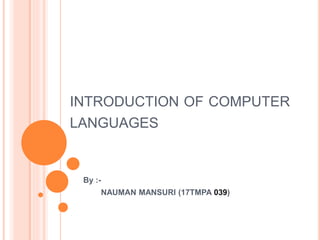Introduction to computer languages NAUMAN
•Download as PPTX, PDF•
1 like•91 views
BASIC AND BEST PPT ON LANGUAGES INCLUDING BASIC OVERVIEW OF PROGRAMMING LANGUAGES
Report
Share
Report
Share

Recommended
More Related Content
What's hot
What's hot (20)
Logical programming languages and functional programming languages

Logical programming languages and functional programming languages
Generations of programming_language.kum_ari11-1-1-1

Generations of programming_language.kum_ari11-1-1-1
Similar to Introduction to computer languages NAUMAN
ITFeatures of machine language, assembly language, high level language & their ...

Features of machine language, assembly language, high level language & their ...SHUBHAM PATIDAR FISHERIES ADDAA
Similar to Introduction to computer languages NAUMAN (20)
Features of machine language, assembly language, high level language & their ...

Features of machine language, assembly language, high level language & their ...
Abstraction level taxonomy of programming language frameworks

Abstraction level taxonomy of programming language frameworks
Recently uploaded
Recently uploaded (20)
Introduction to Casting Processes in Manufacturing

Introduction to Casting Processes in Manufacturing
Cloud-Computing_CSE311_Computer-Networking CSE GUB BD - Shahidul.pptx

Cloud-Computing_CSE311_Computer-Networking CSE GUB BD - Shahidul.pptx
Construction method of steel structure space frame .pptx

Construction method of steel structure space frame .pptx
The Benefits and Techniques of Trenchless Pipe Repair.pdf

The Benefits and Techniques of Trenchless Pipe Repair.pdf
Immunizing Image Classifiers Against Localized Adversary Attacks

Immunizing Image Classifiers Against Localized Adversary Attacks
LIGA(E)11111111111111111111111111111111111111111.ppt

LIGA(E)11111111111111111111111111111111111111111.ppt
Danfoss NeoCharge Technology -A Revolution in 2024.pdf

Danfoss NeoCharge Technology -A Revolution in 2024.pdf
Introduction to Machine Learning Unit-4 Notes for II-II Mechanical Engineering

Introduction to Machine Learning Unit-4 Notes for II-II Mechanical Engineering
Final project report on grocery store management system..pdf

Final project report on grocery store management system..pdf
Online blood donation management system project.pdf

Online blood donation management system project.pdf
RS Khurmi Machine Design Clutch and Brake Exercise Numerical Solutions

RS Khurmi Machine Design Clutch and Brake Exercise Numerical Solutions
A case study of cinema management system project report..pdf

A case study of cinema management system project report..pdf
Sachpazis:Terzaghi Bearing Capacity Estimation in simple terms with Calculati...

Sachpazis:Terzaghi Bearing Capacity Estimation in simple terms with Calculati...
Introduction to computer languages NAUMAN
- 1. INTRODUCTION OF COMPUTER LANGUAGES By :- NAUMAN MANSURI (17TMPA 039)
- 2. WHAT ARE COMPUTER LANGUAGES? o Computer language is language which consists of set of instructions given to a computer. o This instructions include logical steps which are arranged in a specific manner to get desired output.
- 3. TYPES OF COMPUTER LANGUAGES: There are mainly two types of computer languages :- 1. Low level languages . 2. High level languages.
- 4. LOW LEVEL LANGUAGES Low level languages are languages in the form of binary numbers (0 and 1) or language close to it. There are two types of low level language:- 1. Machine language. 2. Assembly language.
- 5. MACHINE LANGUAGES It is lowest and most elementry language. it is only in the form of binary digits i.e. machine code. The set of binary codes which can be recognize by the computer is known as the machine code. Advantages:- 1. It makes fast and efficient use of the computer 2. It requires no translator to translate the code i.e. directly understood by the computer. Disadvantages:- 1. All operation codes have to be remembered 2. All memory addresses have to be remembered 3. It is hard to amend or find errors in a program written in the machine language 4. These languages are machine dependent .
- 6. ASSEMBLY LANGUAGE It is written in form of mnemonic codes. It is also known as ‘symbolic programming language’. Advantages:- It is easier to understand and use as compared to machine language. It is easy to locate and correct errors. It is modified easily. Disadvantages:- Like machine language it is also machine dependent. Since it is machine dependent, there programmer should have the knowledge of he hardware also.
- 8. HIGH LEVEL LANGUAGES:- These languages includes english words and mathematical symbols instead of using mnemonic codes . Types of high level languages:- 1. Algebric formula type processing. 2. Business data type processing. 3. String and list processing. 4. Multipurpose language. 5. Simulation.
- 10. Algebraic Formula-Type Processing. These languages are oriented towards the computational procedures for solving mathematical and statistical problems. Examples are BASIC (Basic All Purpose Symbolic Instruction Code) FORTRAN (Formula Translation). PL/1 (Programming Language, Version 1). ALGOL (Algorithmic Language). APL (A Programming Language). Business Data Processing. These languages emphasize their capabilities for maintaining data processing procedures and files handling problems. Examples are: COBOL (Common Business Oriented Language) RPG (Report Program Generator).
- 11. String and List Processing. These are used for string manipulation including search for patterns, inserting and deleting characters. Examples are: LISP (List Processing). Multipurpose Language. A general purpose language used for algebraic procedures, data and string processing. Examples are: 1. Pascal . 2. PL/1 (Programming Language, version 1). 3. C language. Simulation: These may be written in algebraic or multipurpose languages. Examples are: 1. SPSS (Statistical Package System Simulator). 2. GPSS (General Purpose System Simulator)
- 12. Advantages:- User-friendly (people based). Similar to English with vocabulary of words awl symbols therefore it is easier to learn. They require less time to write and maintain. Problem oriented' rather than 'machine' based Shorter than their low-level equivalents. It is independent of the machine Disadvantages: A high-level language has to be translated into the -machine language by a translator and thus a price in computer time is paid. The object code generated by a translator might be inefficient compared to an equivalent assembly language program.